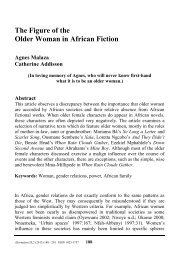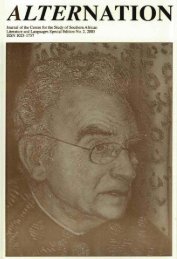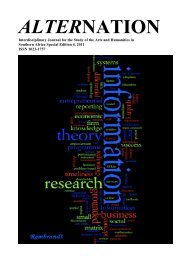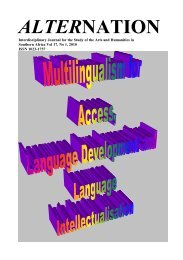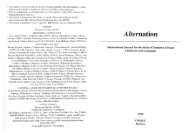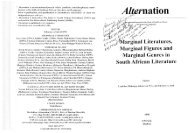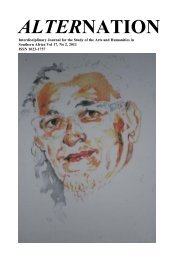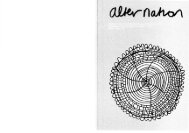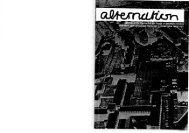Re-reading The Purloined Letter - Alternation Journal
Re-reading The Purloined Letter - Alternation Journal
Re-reading The Purloined Letter - Alternation Journal
You also want an ePaper? Increase the reach of your titles
YUMPU automatically turns print PDFs into web optimized ePapers that Google loves.
371<br />
<strong>Re</strong>-<strong>reading</strong> <strong>The</strong> <strong>Purloined</strong> <strong>Letter</strong><br />
engaged. <strong>Re</strong>ading the method of appropriation as a key to the method of<br />
concealment, Dupin surmises that the best way of hiding the object is to<br />
place it on show. Dupin states:<br />
do you not see the Prefect has taken it for granted that all men<br />
proceed to conceal a letter … in some out-of-way hole or corner …<br />
such researcher’s nooks for concealment are adapted only for<br />
ordinary occasions (Poe, Selected Writings 1984:374).<br />
Dupin looks elsewhere—not in a hiding place, but in the open room and at<br />
what lies right in front of him. He visits the Minister, and spies the letter<br />
hanging visibility from a rack on the mantelpiece. <strong>Re</strong>peating the Minister’s<br />
initial act of appropriation, Dupin substitutes another in its place, and is able<br />
to return the original to the Queen—a scene which repeats the first ‘primal<br />
scene’, but, with a key difference, for the second time round, a solution is<br />
reached, not a problem created.<br />
Lacan’s seminar on <strong>The</strong> <strong>Purloined</strong> <strong>Letter</strong> formed part of a series he<br />
presented in 1955 on Freud’s Beyond the Pleasure Principle entitled <strong>The</strong><br />
Ego in <strong>The</strong> <strong>The</strong>ory of Freud and in the Technique of Psychoanalysis. Beyond<br />
the Pleasure Principle, published just after the First World War, according<br />
to Williams (1995:55), is best known as Freud’s primary articulation of the<br />
theory of the death drive—a complex of ideas attempting to explain certain<br />
puzzling psychic phenomena which didn’t ‘fit into’ Freud’s earlier accounts<br />
of desire and mental regulation. Freud was also faced with the phenomenon<br />
known as ‘repetition compulsion’, and in its role as a response to Beyond the<br />
Pleasure Principle, Lacan’s essay on <strong>The</strong> <strong>Purloined</strong> <strong>Letter</strong> forms an<br />
extended meditation upon ‘repetition compulsion’. For Freud, according to<br />
Williams (1995:55f), pain and the possibility of pleasure in pain, was crucial<br />
to ‘repetition compulsion’. One of the factors which led him to the<br />
formulation of the death drive was the phenomenon whereby those who had<br />
experienced extreme trauma continued to relive the trauma, with no apparent<br />
resolution, in fantasy, long after the original moment had passed. For Lacan,<br />
according to Williams (1995:56), the question of repetition is focused on<br />
loss than on pain and <strong>The</strong> <strong>Purloined</strong> <strong>Letter</strong>, with its repeated losses of a<br />
circulating object (first by the Queen, and then by the Minister), becomes in<br />
Lacan’s <strong>reading</strong> a crucial literary articulation of this compulsion. At the



